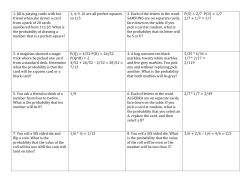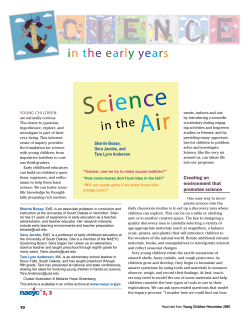
A Note to the Teacher About Using the Glow Stick... By Ron Thompson, Biology Teacher
A Note to the Teacher About Using the Glow Stick Lab Can You Catch a Fish on a Moonbeam? By Ron Thompson, Biology Teacher For years I have looked for a highly motivating lab activity that would inspire students and introduce them to inquiry on the very first day. I had tried all types of activities and they were only mildly effective. After creating this activity, and trying it for the first time with students, I knew immediately that this was it. Every time I present this activity at science workshops of any kind, the response is extremely positive. Workshop participants immediately ask, “Where can I get these glow sticks?” They indicate they intend to incorporate this activity into their curriculum as soon as possible. The glow stick activity meets all the requirements I have for an inspiring “first lab experience.” • • • • • • • • • It’s an activity that “sells students on science” from the very first day The cost is low It takes very little time to set up It does not require elaborate equipment It is highly motivational and students respond positively in the first 10 minutes All students succeed in performing this activity It introduces students to every step in the inquiry process in a concrete manner Appropriate results are always obtained: “It works.” The chemical reaction in the sticks is one found in living organisms The scientific inquiry process can be intimidating to some students, particularly when presented as a list of steps. Since this is a concrete, hands-on, fun activity, students have no problem understanding the process. This is a relatively easy activity to insure that all are successful. What students learn can easily be built upon as they progress through the course and master more sophisticated aspects of inquiry. For these reasons and many others, the glow stick lab activity is an IDEAL LAB ACTIVITY TO USE THE FIRST WEEK, IF NOT THE FIRST DAY Try this activity at anytime if you have just been introduced to it. Then see if you don’t agree that it would be ideal as the first activity of the year for the following September. Complete set up instructions for the teacher follow this activity. Connecting Point NW Phone (206) 230-8360 ThompsonRon@Me.com www.BioInquiry.com 1 © Connecting Point NW, 2013 Student Laboratory Investigation 2-1 Can You Catch a Fish on a Moonbeam? Objective: You will be expected to experimentally determine if a fishing lure will emit light as advertised under conditions in which it would be used. PRE LAB: If unopened packages of glow-sticks are at your table: Open the two packages at your table and bend the flexible plastic glow-stick until you feel the fine glass tube inside break. [___] You should notice the stick begin to glow. Shake it back and forth. If it has not begun to glow, bend it a little more. [___] If the packages have already been opened: If the glow-sticks at your table already glow, the students before you have opened them and you may proceed to the next step. Quite an amazing reaction is taking place inside of the glow-stick. When the thin glass vial containing a chemical catalyst was broken, the chemical mixed with the chemical outside the glass vial and the two chemicals reacted together to produce light. Similar reactions take place in glowworms, fireflies, and in certain algae and other living plants and animals. The room lights will need to be turned off for this experiment. After the lights are out, see if you can use the glow-stick to enable you to read the following instructions. Question 1: Can you read the instructions with the aid of the glow-stick? Explain. Work as a team at your table and set up two beakers of water; set up one at about 45 degrees C. and another at about 22 degrees C. (room temperature). Use tap water and a thermometer to create 22 degree water. Obtain warm tap water for the 45 degree temperature. [___] You should have two glow-sticks at each table. Place one into the room temperature water and one into the warm water. [___] Question 2: After one or two minutes, describe your observations for each stick. Now remove the sticks from both beakers, dry them and set them on the table and wait one to two minutes and then answer question 3. [___] Question 3: What did you observe happening as the two sticks changed back to room 2 © Connecting Point NW, 2013 temperature while on the table? Question 4: What appears to be the relationship between the amount of light given off by a glow-stick and temperature? INVESTIGATION PROCEDURE: In this investigation you will work as a team at your table; however, each student is to write his or her own report. Feel free to discuss answers but put written responses into your own words. PROBLEM TO BE SOLVED: What is the relationship between temperature and the amount of light given off by the glow-stick? Copy the problem in the box above into your lab report. Label it "Problem to be solved." [___] HYPOTHESIS: Write a hypothesis for the question in the above box. A hypothesis is a possible answer to a question. Your hypothesis should describe what you believe to be the relationship between temperature and the amount of light given off by a glow-stick. [___] EXPERIMENTAL PLAN After the heading, "EXPERIMENTAL PLAN" in your report, write a detailed plan for how you will set up an experiment to test your hypothesis. Be sure to set up a control beaker and an experimental beaker. Have your teacher approve your plan before you go on. [___] THE EXPERIMENT Your control should be a beaker with water at about 22-24 degrees C (room temperature). Place one glow-stick into this beaker. The control beaker containing the glow-stick should remain on the table for the duration on the experiment. Set up any other beakers based upon your experimental plan and reuse the glow-stick each time. Wait at least two minutes before recording the results. [___] 3 © Connecting Point NW, 2013 Question 5: What is the purpose of the control beaker? DATA (RESULTS OF THE EXPERIMENT) Place these results after the heading "DATA" on you lab report. [___] Record the results obtained in a neat data chart similar to the one below: Temperature Brightness 37 27 17 10 etc. You might use a system of stars to illustrate brightness. For example, ***** = brightest. Use *, **, *** and **** to correspond to different degrees of brightness between maximum and minimum. [___] ANALYSIS, INTERPRETATIONS AND CONCLUSIONS: Question 6: What does the additional data collected tell you about the relationship between temperature and the amount of light produced in this reaction? Question 7: At about what temperature did you observe the least light emitted? CONCLUSION REGARDING HYPOTHESIS: Question 8: How close was your hypothesis to being correct? Explain. These glow-sticks have been advertised for use as fishing lures. Your teacher may have a copy of one of these advertisements. The ad explains how the stick will glow in water and attract fish. Many of the rivers commonly fished in Washington State are between 2 degrees C. and 6 degrees C. Question 9: Will the glow stick be an effective lure in water this cold? Explain. Question 10: In your opinion and based upon your data, how warm does the water need to be to cause the glow-stick to give off enough light to attract fish? Your teacher will have you place the sticks in the refrigerator for the next class to use. 4 © Connecting Point NW, 2013 TEACHER’S INSTRUCTIONS FOR: CAN YOU CATCH A FISH ON A MOONBEAM? I. Concepts taught: A. Content objective: The observed chemical reaction observed in glow sticks that causes light to be emitted is affected by temperature. The greater the temperature, the more light emitted. B. Process objective: This activity is designed to be a fascinating, yet elementary introduction to the scientific process. Most steps in the scientific inquiry process are presented and defined. The problem is one that is very easy to solve. II. Prerequisite Knowledge: None. III. Time requirements: 40-50 minutes. IV. Teaching strategies: Use this popular activity as your student’s first lab experience in your biology course. The laboratory will take on a very unconventional appearance. The lights will be out. The student’s work and faces will be illuminated by an eerie green light emitted by a small glow-stick. This is a fascinating introduction to the scientific inquiry process and to your course. This first lab is designed to motivate students and cause them to look forward to what comes next and anticipate exciting, out of the ordinary things. The [___] symbol seen in the student version of this lab tells the students to stop reading at that point and do what was asked of them and then to continue reading at the same point. All Biology: As Scientific Inquiry lab activities employ this strategy. V. Materials needed and set-up instructions: Set up 8 trays. (one tray per table or group of 4 students) In each tray place the following: • glow sticks Most schools prefer to use the 1 1/2 inch glow sticks for this lab activity since they are usually the cheapest. You can order these sticks from us at: Connecting Point NW See current prices on our website: www.BioInquiry.com Phone: (206) 230-8360 ThompsonRon@me.com • Keep the sticks in the refrigerator when not in use. You should be able to use one set of sticks all day. • 2 small beakers or transparent plastic containers (100 mL -200 mL range) 5 © Connecting Point NW, 2013 • 1 Celsius thermometer • Have trays of ice and hot and cold tap water available for each class. ThompsonRon@me.com Click here to return to the site’s home page 6 © Connecting Point NW, 2013
© Copyright 2025





















